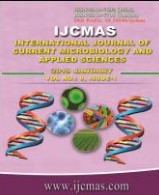


 National Academy of Agricultural Sciences (NAAS)
National Academy of Agricultural Sciences (NAAS)

|
PRINT ISSN : 2319-7692
Online ISSN : 2319-7706 Issues : 12 per year Publisher : Excellent Publishers Email : editorijcmas@gmail.com / submit@ijcmas.com Editor-in-chief: Dr.M.Prakash Index Copernicus ICV 2018: 95.39 NAAS RATING 2020: 5.38 |
The relentlessly increase of atmospheric carbon dioxide (CO2) concentration due to release from different sources leads to global warming and climate change which are a cause for great concern demanding in-depth research on CO2 emission from soil under different forest cover. Forest cover can reverse the increasing CO2 in the atmosphere, thus, contributes to mitigate climate change. Forest stored about half of the organic carbon (C) contained in terrestrial ecosystems. The role of forests has a great impact on the global biogeochemical cycles and in particular, the carbon cycle. Larger parts of the global C stock are stored in forest ecosystems. So, identifying the tree species in a forest with high SOC, soil organic carbon stocks (SOCS) and high C sequestration with low CO2 emission is a priority for mitigating the global climate change. Carbon sequestration in forest occurs in both aboveground and below ground biomass. But, the below ground C sequestration was quite low in comparison to the above ground. The rate of C sequestration in Schizostachyum pergracile dominant forest was 22.03 Mg ha–1 year–1 whereas for Dipterocarpus tuberculatus dominant forest was only4.64 Mg ha-1 year-1. The annual organic C input (gCm-2year-1) as litter fall of forest dominated by Quercus serrata + Schima wallichii and Ficus virens + Cinnamomum zeylanicum, were 424.21 and 374.83 respectively. The naturally standing forest with dominant tree species of Quercus serrate or combination with other species was found to be most efficient in C sequestration as well as low efflux of CO2followed by Schizostachyum pergracile bamboo forest. Any land use change of these forest cover can leads to more efflux of CO2 making more vulnerable to global warming and climate change. SOC showed negative correlation with soil bulk density but with clay content in soil it is positively correlated. From the present investigation most of the naturally standing oak tree forest contributes high rate of SOC, SOCS and carbon sequestration, hence it is suitable for mass plantation to mitigate against human induced climate change.
 |
 |
 |
 |
 |